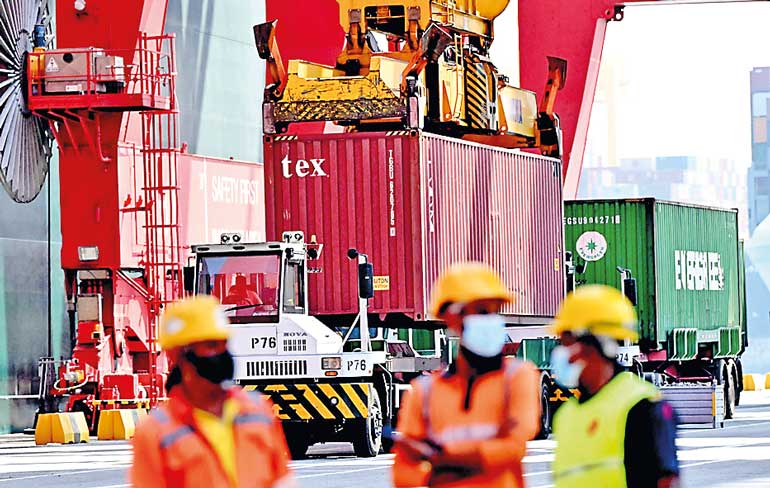Monday Apr 07, 2025
Monday Apr 07, 2025
Tuesday, 27 September 2022 00:56 - - {{hitsCtrl.values.hits}}

The latest bi-annual Export Barometer Survey indicates that exporters are increasingly concerned about the implications of the expected contraction of the Sri Lankan economy in the latter half of 2022 on export orders, with SMEs particularly vulnerable to the intensifying economic crisis.
The third in a series of surveys conducted by the Ceylon Chamber of Commerce (CCC) and the United States Agency for International Development (USAID) – supported Partnership for Accelerating Results in Trade, National Expenditure and Revenue (PARTNER) activity, this survey received responses from 157 exporters of goods and services.
The majority of these respondents were SME firms, with women-owned and/or women-led firms accounting for 20%.
The survey, compiled in July-August, builds on the findings from previous reports published in August/September 2021 and February/March 2022 and tracks trends and sentiments related to Sri Lanka’s export performance, challenges faced by exporters, and ways in which firms are continuing to navigate the economic crisis.
It also presents measures required to enhance export competitiveness and the outlook for the export sector for the second half of 2022.
Pessimism is despite earnings from merchandise exports in August growing year on year by 5.4% in July to a record $ 1.16 billion and cumulative earnings in the first seven months increasing by 13% to $ 7.67 billion.
The key insights of the survey are as follows:
1.Outlook on economy and export orders deteriorate significantly
Most exporters predict the economy to fall moderately to severely in the second half of 2022, and a sizable percentage anticipates a similar trend in export orders. The latter trend indicates a considerable shift in exporter sentiment since the previous survey in February/March 2022.
2.Large firms display more resilience than SMEs
Exporters continued to be resilient in the face of an intensifying economic crisis, particularly in the export of goods, which grew 14% in the first half of 2022 compared to the same period in 2021. However, the survey highlighted that larger firms performed better in export revenue growth, capacity utilisation, and sourcing of new export opportunities compared to SMEs.
3. Key challenges due to fuel and power shortages
Exporters across all categories of firms, including women-owned and/or women-led businesses, faced challenges in meeting their existing orders due to fuel and power shortages, while increases in transport costs and policy uncertainty worsened the situation. Firms also highlighted that the current economic situation will have a long-term negative impact on buyer confidence in Sri Lankan exports.
4.Employment trends turn negative
Employment trends turned negative in the first half of 2022, with more firms looking at cost-cutting measures. Most firms were facing attrition led by employees migrating due to the current crisis. Nevertheless, 64% of firms are not expecting a change in their workforce size in the second half of 2022.
5.Political stability and continuous power supply required to sustain export momentum
Exporters requested facilitation measures to fulfil export orders, with reduced focus on requests to improve export competitiveness. Minimising power shortages and maintaining political stability were the top priorities. Women-owned and/or women-led businesses and SMEs continued to request more facilitation in exploring new markets and access to trade/export finance.
6. Service exporters more optimistic about the economic and business outlook
Service exporters were more optimistic that their businesses would see moderate to high growth in the second half of 2022 and that the economy would improve compared to goods exporters (31% compared to 22%).
7. Greater outreach of exporters beyond the Western Province
The third survey received more responses from firms outside the Western Province compared to the last two surveys. Responses from the Western Province fell to 62% from 82% in the previous survey. In addition, this survey received more responses from service exporters (11%) than the previous survey (3%). As such, this survey achieved greater regional reach and a more diverse representation of firms.
Access the full at Trade Watch (https://www.chamber.lk/trade-watch/) or click http://www.chamber.lk/trade-watch/backend/public/uploads/attachments/article/ExportBarometer_3rdSurveyReport_FINAL_15.09.2022_1663299829.pdf.


Discover Kapruka, the leading online shopping platform in Sri Lanka, where you can conveniently send Gifts and Flowers to your loved ones for any event including Valentine ’s Day. Explore a wide range of popular Shopping Categories on Kapruka, including Toys, Groceries, Electronics, Birthday Cakes, Fruits, Chocolates, Flower Bouquets, Clothing, Watches, Lingerie, Gift Sets and Jewellery. Also if you’re interested in selling with Kapruka, Partner Central by Kapruka is the best solution to start with. Moreover, through Kapruka Global Shop, you can also enjoy the convenience of purchasing products from renowned platforms like Amazon and eBay and have them delivered to Sri Lanka.
Discover Kapruka, the leading online shopping platform in Sri Lanka, where you can conveniently send Gifts and Flowers to your loved ones for any event including Valentine ’s Day. Explore a wide range of popular Shopping Categories on Kapruka, including Toys, Groceries, Electronics, Birthday Cakes, Fruits, Chocolates, Flower Bouquets, Clothing, Watches, Lingerie, Gift Sets and Jewellery. Also if you’re interested in selling with Kapruka, Partner Central by Kapruka is the best solution to start with. Moreover, through Kapruka Global Shop, you can also enjoy the convenience of purchasing products from renowned platforms like Amazon and eBay and have them delivered to Sri Lanka.